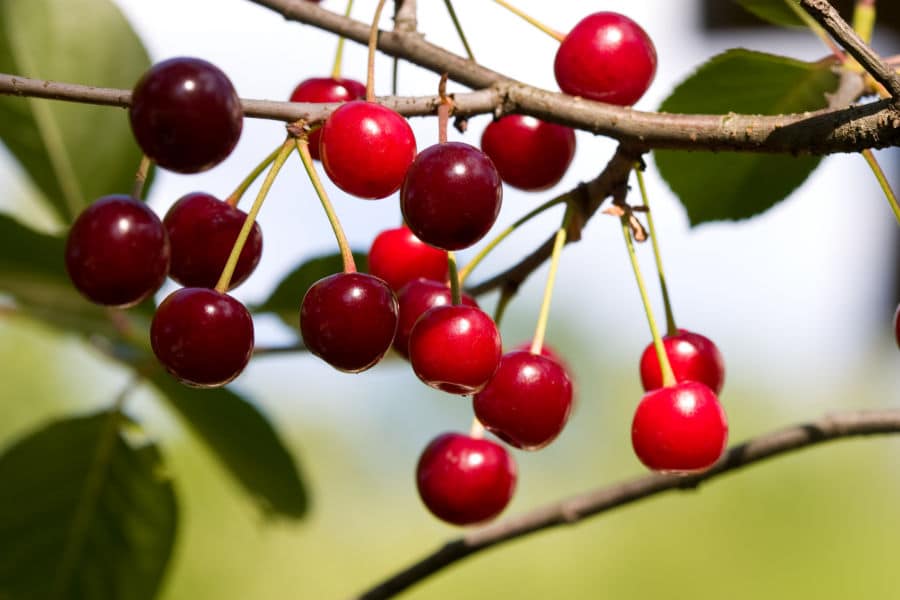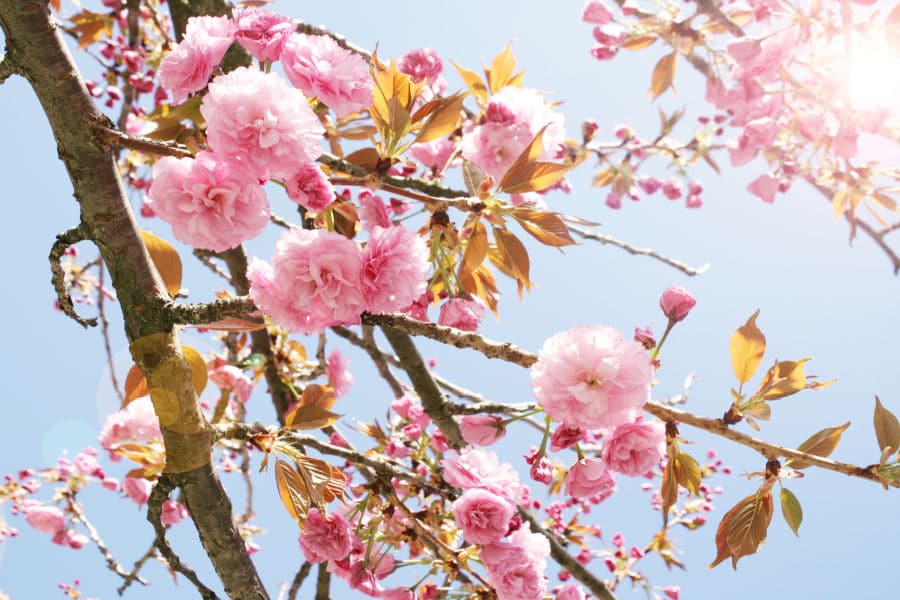
Cherry Trees: A Comprehensive Guide
Are you interested in planting some eye-popping cherry trees in your yard? They are generally grown for two main reasons: either the tasty juicy cherries they yield, or for the magnificent splendor these lovely specimens add to the yard during Spring when they are blanketed in white, pink and purple flowers!
Cherry Tree Varieties

There are a large variety of cherry trees, some of which are better for ornamental purposes whereas others yield delicious fruit. Some common cherry tree varieties include Weeping, Tibetan, Higan, Yoshino, Japanese, and many more.
In terms of fruit-producing trees, there are two main varieties - sweet cherry trees and sour cherry trees, (and, also, the very rare cross product of both - the dukes).
Sweet Cherry
These trees yield the same sweet plump-like cherries that you would most likely find stalled around the market. These cherries take a heart shape and a bold red blackish color. With sweet cherry trees, you would typically want two to three planted nearby to cross-pollinate and begin flowering.
Sour Cherry
Sour cherry trees, on the contrary, produce tart or sour flavored cherries. The cultivation of these cherries is more dedicated to canning, preparation of pies and jellies, cooking, baking, and other preservation purposes. That is because they have a much higher acidic content and are not preferred for eating fresh.
Shape & Size

Cherry trees range in height from an 8 foot sour cherry tree to ten times taller (80 feet high) wild cherry tree. The height and size depends upon the type, cultivar species, and dwarfing rootstock.
A standard sweet cherry tree is expected to grow up to a height of 35 feet with a spread of 25 feet. These trees are pyramid-shaped; however, you can train them to roll out against a fence or wall. They are deciduous and lose their rich green leaves will turn gold in the Fall. Conversely, the tart or sour cherry trees grow up to a moderate height of 20 feet and are equally wide. These trees are round in shape and make excellent shrubs and hedges. They have deep green egg-shaped Spring leaves, which take an orangish-brown color during fall.
Climate Requirements of Cherry Trees

Cherry trees can be grown in all areas where Winter is not extremely severe and Summers are relatively mild. Like other deciduous trees, they require enough chilly hours to produce a healthy crop. These cold hours may vary from 400 to 900 hours, depending upon the tree variety and region. Most of the cherry varieties go well with the U.S. hardiness zones 4 to 9.
Sweet cherry trees are best grown in places where the temperature is mild, whereas sour cherry trees are well suited for cooler areas and will require a certain number of winter hours below 45° F.
When Will a Cherry Tree Generate Fruit?

Cherry trees are fast-growing trees and would expectedly start bearing fruit by the time they are four years old (a year earlier in case of dwarf trees). A mature standard tree can yield up to 50 quarts of cherries each year, whereas a dwarf tree should produce no less than 15 quarts of cherries. Either way, that's quite a handsome return! These trees can sustain well for a good 15 to 30 years.
What is So Special About Cherry Trees?

What makes cherry trees special is their mesmerizing splendor during the peak season accompanied by a prolific harvest of juicy red cherries. Cherry blossoms speak of life after the cold days and frozen nights of Winter. The bloom of the cherry tree symbolizes the merriest moments of Spring.
Nearly all cherry trees bloom during early Spring with profoundly gorgeous whitish-mauve flowers that are highly fragrant. These flowers hang down the branches of cherry trees in clusters before crops of silky red cherries emanate from them.
Useful Tip: As much as we love this grand floral spell of these trees, birds, and insects are no different. To save your cherries from being shared with birds, insects, and other wild species, bring in some scarecrows or use netting.
As the seasons progress, so does the cherry tree. From deep green during Summer, these leaves take a striking orange color during Fall, before they fall off the tree leaving it crisply bare during winters.
Whether you wish to snack on home-grown cherries or you want to accent your landscape with the best of ornamental trees, planting a cherry tree is always a great decision to make!
Where to Plant a Cherry Tree?

It is important to take certain things into consideration when planting a cherry tree. Below we highlight some of the most important ones.
- Cherry trees are prone to root rot, brown rot, bacterial canker, and other diseases, and so they require a well-drained moist soil to thrive. They prefer soil having pH levels between 6.0 – 6.8. Fast-draining sandy soils or heavy clay that holds in water after rain has passed is never a very good option.
- Cherry trees require full sunlight for 8 hours a day and should be planted at a sunny site with good air circulation. It is ill-advised to plant them somewhere in the shade of fellow trees where they are unable to soak up enough sunlight. The growth of cherry trees will also suffer when planted in highly foggy areas.
- The breathtaking blossoms can be problematic if you do not consider the surroundings beforehand (i.e. any wires or other obstructions nearby). Make sure to offer enough space between trees and other surrounding objects like a building, wall, sidewalk, driveway etc. Also, plant it such as to not block the view with its great splendor when fully grown.
- All sweet cherry trees require cross-pollination (except for 'Stella' specimens). Make sure to have two or more varieties of cherry trees planted for a better fruit-set. On the contrary, all sour cherry trees are self-pollinators and should bear fruit without having to pollinate with fellow species.
- Look out for the health of your tree and add necessary fertilizers and compost when needed as cherry trees respond well to soil additives. Also, they are susceptible to pests and other diseases – so keep an eye on them.
Interesting Facts About Cherry Trees

- Black cherry trees have a lifespan up to 250 years!
- The blossoms and the leaves of certain varieties are edible. These are sometimes used for making pickles, sweets, and tea
- While most bloom with flowers ranging shades of pink and white, some varieties begin blooming with flowers of a yellowish-green shade later changing into hues of white and pink
- The oldest cherry tree in Japan named as Jindai Zakura has been flowering since it was planted some 2000 years ago
- Mature trees can produce up to 7000 cherries each year, and if cared for properly, these can live up to 100 years
- More than 97% of sweet cherries of the USA come from the combined harvest of Oregon, California, and Washington, while Michigan tops the sour cherry producing chart
